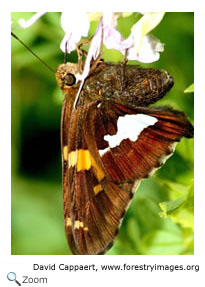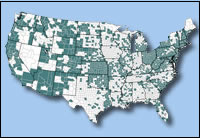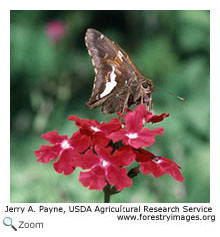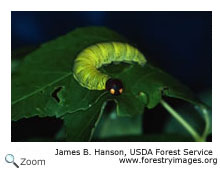Description
 The silver-spotted skipper has a wingspan of 1.5 to 2.5 inches. It has sharply-pointed, triangular forewings. It is dark brown on its uppersides and undersides. It has a yellow band on the upperside and the underside of its forewings. It gets its name from the large silvery spot on its hindwings. The silver-spotted skipper has a wingspan of 1.5 to 2.5 inches. It has sharply-pointed, triangular forewings. It is dark brown on its uppersides and undersides. It has a yellow band on the upperside and the underside of its forewings. It gets its name from the large silvery spot on its hindwings.
Range  The silver-spotted skipper is found from British Columbia , Canada east to Quebec, Canada and south throughout most of the United States and into northern Mexico. The silver-spotted skipper is found throughout New Hampshire. The silver-spotted skipper is found from British Columbia , Canada east to Quebec, Canada and south throughout most of the United States and into northern Mexico. The silver-spotted skipper is found throughout New Hampshire. |
|
|
|
Habitat
The silver-spotted skipper is found in open woodlands and brushy areas.
Diet  The silver-spotted skipper caterpillar eats plants in the legume or Fabaceae family, especially
the black locust,
bush clover, and false indigo. The adult almost never gets nectar from yellow flowers! It prefers
red, pink, purple, blue, and occasionally white flowers including:
milkweed, red clover, buttonbush, blazing star, and thistles. The silver-spotted skipper caterpillar eats plants in the legume or Fabaceae family, especially
the black locust,
bush clover, and false indigo. The adult almost never gets nectar from yellow flowers! It prefers
red, pink, purple, blue, and occasionally white flowers including:
milkweed, red clover, buttonbush, blazing star, and thistles.
Life Cycle
 The male silver-spotted skipper perches on a tree branch or a blade of tall grass and waits for a female. He chases away insects that get too close to his perch! The female lays one egg at a time near a host plant. The silver spotted-skipper produces more than one brood a year. Silver-spotted skipper
larvae
have a green body and a brown head with two orange spots that look like eyes. The male silver-spotted skipper perches on a tree branch or a blade of tall grass and waits for a female. He chases away insects that get too close to his perch! The female lays one egg at a time near a host plant. The silver spotted-skipper produces more than one brood a year. Silver-spotted skipper
larvae
have a green body and a brown head with two orange spots that look like eyes.
|